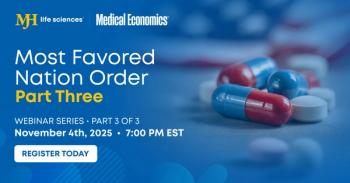
- October 25, 2019 edition
- Volume 96
- Issue 20
Assisting patients with rising costs of prescription drugs
Data from the Centers for Medicare and Medicaid Services reveals that on average, Americans spend approximately $1,200 a year on prescription medications, numbers that have gone up due to rising prices. Here's how doctors can help.
Prescription drug prices are on the rise. Data from the Centers for Medicare and Medicaid Services reveals that on average, Americans spend approximately $1,200 a year on prescription medications, numbers that have gone up due to rising prices.
In fact, a recent study by the Kaiser Family Foundation showed that nearly one-third of patients say they’re skipping prescription medicine because of the cost. That same study noted four out of five Americans believe the cost of prescription drugs is unreasonable.
Viquar Mundozie, MD, FAAFP, a family physician at Mercyhealth Harvard South in Harvard, Ill., says he often sees patients having to choose between fulfilling daily necessities versus taking medications.
“Many Medicare patients are desperate for help affording meds,” he says. “As primary care providers, the burden of inflated drug prices comes as urgency and we need to be proactive in speaking up and advocating for our patients. This not only helps our patients but entire communities and our nation.”
David Belk, MD, an internist in Alameda, Calif., says it’s important to understand that the rising cost of prescription drugs usually applies to brand name medications. He’s seen studies showing that apprpoximately 87 percent of prescriptions filled in the U.S. in the last two years were for generic medications, and since pharmacies purchase most generic medications for pennies a pill, this is one way costs can be lowered.
“People really need to know this because the cash price for many of these prescriptions can often be less than the insurance copay for the same medication,” he says.
For example, Atorvastatin 20 mg (generic Lipitor) can be purchased for a cash price of about $16 for 100 pills. But that same 100 pills of Lipitor will costs more than $1,400. According to CMS, pharmacies in the U.S. paid an average of 9 cents a pill for Atorvastatin and just over $14 a pill for branded Lipitor.
Another thing that can help alleviate some cost is contacting the pharmaceutical company and asking for discounts for copays. This is a method that Belk has seen work for his patients.
Help is available
As of July 2019, more than 3,400 drugs have increased in price, a 17 percent increase compared with the nearly 2,900 drug price hikes at the same time in 2018, according to a new analysis by Rx Savings Solutions, which provides pharmaceutical advice to health plans and employers.
“We need lawmaker to implement legislation that puts a cap on price inflation by drug companies,” Mundozie says.
He notes there are some resources that can help, including assistance programs to those eligible offered by pharmaceutical companies, nonprofit groups or state governments.
To get the assistance process started, he says, patients need to fill out an application with the drug manufacturer. If the patient qualifies, the doctor might have to provide additional information. Then the drugs are either mailed to the patient or their primary care physician.
While a specialist could do this as well, Mundozie says it’s usually primary physicians due to a close and long-term relationship with the patients, since these meds need to be prescribed for a long time and papers need to filled periodically.
“We have a nurse coordinator that helps our patients get the process started and makes sure they understand the process and helps them get their medications on a regular basis,” Mundozie says.
Many states offer drug assistance programs. These vary and tend to be geared toward the elderly, the disabled, those in financial need, or patients with specific conditions, like HIV/AIDS or end-stage renal disease.
In addition, there are assistance programs run by nonprofit groups, such as Partnership for Prescription Assistance, that help low-income, uninsured patients get free or low-cost brand-name medications.
Thomas Sullivan, MD, a cardiologist with 44 years of clinical practice experience and former associate medical director of Blue Cross Blue Shield of Massachusetts, says when a physician prescribes a new drug, the problem is that the patient and prescriber typically do not know the copay until the pharmacist checks the patient’s coverage. If the copay is unaffordable in the eyes of the patient, then it requires a usually inconvenient call or return visit to the prescriber to discuss alternatives. This might take considerable time and delay treatment.
That’s why DrFirst and Humana created “myBenefitCheck” (widely known in the industry as Real-time Benefit Check), which enables patients and providers to collaborate on medication selection based on a patient’s current insurance benefit and potential out-of-pocket costs.
“Physicians are now able to quickly look up what the copay is while the patient is with them in the office and know the exact copay before it is sent to the pharmacy,” Sullivan says.
Apps can help
There are also a multitude of apps that doctors and patients can use to help find lower prices for prescription drugs. For instance, Mundozie has had great success with the app GoodRX, which offers price comparison among pharmacies near a specific location so a patient gets the most benefit in savings on their prescriptions.
“Prescription drug prices can vary widely from pharmacy to pharmacy, even if you have insurance,” he says. “This app shows you the comparative prices at the local pharmacies so patients can choose to go to the pharmacy that saves them the most.”
Articles in this issue
about 6 years ago
2019 EHR Scorecard: Physicians rate their EHR systemsabout 6 years ago
Fixing EHRsabout 6 years ago
E/M coding changesabout 6 years ago
Bipartisan support keeps telehealth adoption moving forwardNewsletter
Stay informed and empowered with Medical Economics enewsletter, delivering expert insights, financial strategies, practice management tips and technology trends — tailored for today’s physicians.


















